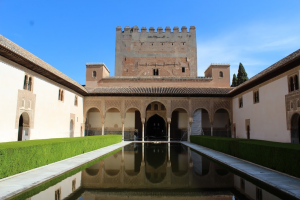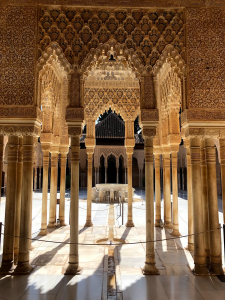
The Alhambra walls
Overlooking the town of Granada is the Alhambra. What was once the home of many Sultans and Kings, is now the most visited monument in Spain. Inside the doubled walled fortress sits the Alcazaba (the military barracks and watchtower), the Nasrid Palaces, the Medina (town), and the Generalife (the Sultan’s summer residence). Over time, aspects of the original Alhambra have been lost, with different rulers changing and destroying elements. After the Christian conquest of the city in 1492, Queen Isabella altered parts of the Nasrid Palaces, and in the 16th century, Holy Roman Emperor Charles V had a palace built in his name. In the 1800s the Alhambra was occupied by Napoleon’s troops, who destroyed the Medina, leaving the town in ruins. In 1829, Washington Irving stayed in the Alhambra whilst writing his book, Tales of the Alhambra, which was instrumental in reintroducing the Alhambra and Granada to Western audiences.

The Political Palace
The Nasrid Palaces still feature many of the decorations that they did in the 13th century. The walls are inscribed with quotes from the Quran and are covered with colourful tiles. The ceilings are decorated with stucco or made from intricately inlaid cedar wood. The Palaces are split into three different areas: the public palace, where the townspeople would put forth questions and requests to the Sultan; the political palace, where the administration and state affairs would take place; and the royal palace, the private area reserved for the Sultan, his family, and his harem. Each one is grander and more decorated than the previous. One of the most famous areas within the Palaces is the Court of the Lions, which is meant to represent paradise. Four streams of water flow to the Fountain of Lions, each portraying the four rivers in paradise: water, milk, honey, and wine. The patio features 124 columns; these represent palm trees. In the Sultan’s private bedroom, the ceiling is molded in the shape of an eight-point star. It is adorned to look like the ceiling of a cave covered in stalactites, similar to the cave where Muhammad prayed and recieved the first revelation of the Quran.

The ceiling of the Sultan’s bedroom
A short walk from the Nasrid Palaces is the Generalife, the summer palace of the Nasrid rulers. It is filled with gorgeous green courtyards and has an impressive view of the city. It is likely that the royal family would have spent the days here, and then returned to the Palaces in the evening, to protect themselves against attack.

The Generalife
The Alhambra truly is one of the most beautiful places I have visited in my life. Wandering through the palaces, I was captivated by the beauty of it all. It really was breathtaking! Being able to see a type of architecture so different to any I have seen before was incredible. As we visited early in the morning, we had the Palaces to ourselves – it felt like a private tour! I would recommend visiting!

Charles V Palace
~~~~~~~~~~~~~~~~

The Watchtower
Con vistas a la ciudad de Granada se encuentra la Alhambra. Hoy en día es el monumento más visitado en España, pero una vez fue el hogar de muchos Sultanes y Reyes. Dentro de la fortaleza de doble pared, se encuentra la Alcazaba (los cuarteles militares y la torre de vigilancia), los Palacios Nazaríes, la Medina (la ciudad), y el Generalife (la residencia de verano del Sultán). A lo largo del tiempo, aspectos de la Alhambra original se han sido perdido, como resultado de diferentes monarcas cambiando y destruyendo elementos de la fortaleza. Siguiendo la conquista cristiana de la ciudad en 1492, la Reina Isabella modificó partes de los Palacios Nazaríes, y en el siglo XVI, Carlos V, el Emperador del Sacro Imperio Romano Germánico, construyó un palacio en su nombre. En el siglo XIX, la Alhambra fue ocupada por las tropas de Napoleón, que destruyeron la Medina, dejando la ciudad en ruinas. En 1829, Washington Irving se quedó en la Alhambra mientras escribía su libro, Cuentos de la Alhambra, que fue fundamental en la reintroducción de la Alhambra y Granada al público occidental.
- Example of Stucco decoration within the Palaces
- Arabic writing cover the walls
- Colourful tiles
Los Palacios Nazaríes todavía contienen las mismas decoraciones que lo hicieron en el siglo XIII. Las paredes están inscritas con citas del Corán y están cubiertas con azulejos coloridos. Los techos están decorados con estuco o están hechos de madera de cedro intrincadamente incrustada. Los Palacios se dividen en tres áreas diferentes: el palacio público, donde los habitantes de la ciudad plantearían preguntas y peticiones al Sultán; el palacio política, donde se llevarían a cabo la administración y los asuntos estatales; y el palacio real, la zona privada del palacio que fue reservada para el Sultán, su familia, y su harén. Cada palacio es más grande y decorado que el anterior. Una de las zonas más famosas dentro de los Palacios es la Corte de los Leones, que se supone que representa el paraíso. Cuatro corrientes de agua fluyen a la Fuente de los Leones. Estos representan los cuatro ríos de paraíso: agua, leche, miel, y vino. El patio cuenta con 124 columnas, que representan palmeras. En el dormitorio privado del Sultán, el techo está moldeado en forma de una estrella de ocho puntos. Está decorado para parecer el techo de una cueva cubierta de estalactitas, similar a la cueva donde Mahoma oró y recibió la primera revelación del Corán.

The Court of the Lions
A poca distancia a pie de los palacios nazaríes se encuentra el Generalife, el palacio de verano de los gobernantes nazaríes. Está lleno de hermosos patio verdes y tiene una vista impresionante de la ciudad. Es probable que la familia real hubiera pasado los días aquí, y luego regresado a los Palacios por la noche, para protegerse de ataques.

What remains of the Medina
La Alhambra es verdaderamente uno de los lugares más bellos que he visitado en mi vida. Paseando a través de los palacios, me cautivó la belleza de todo. ¡Fue impresionante! Viendo un tipo de arquitectura tan diferente a cualquier que he visto antes fue increíble. Como visitamos temprano en la mañana, teníamos los Palacios para nosotros mismos – ¡se sentía como un tour privado! ¡Yo recomendaría visitarlo!

The Alhambra



